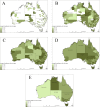Subjective wellbeing at different spatial scales for individuals satisfied and dissatisfied with life
- PMID: 30809461
- PMCID: PMC6387756
- DOI: 10.7717/peerj.6502
Subjective wellbeing at different spatial scales for individuals satisfied and dissatisfied with life
Abstract
Indicators that attempt to gauge wellbeing have been created and used at multiple spatial scales around the world. The most commonly used indicators are at the national level to enable international comparisons. When analyzing subjective life satisfaction (LS), an aspect of wellbeing, at multiple spatial scales in Australia, variables (drawn from environmental, social, and economic domains) that are significantly correlated to LS at smaller scales become less significant at larger sub-national scales. The reverse is seen for other variables, which become more significant at larger scales. Regression analysis over multiple scales on three groups (1) all individuals within the sample, (2) individuals with self-reported LS as dissatisfied (LS ≤ 5), and (3) individuals self-reporting LS as satisfied (LS > 5), show that variables critical for LS differ between subgroups of the sample as well as by spatial scale. Wellbeing measures need to be created at multiple scales appropriate to the purpose of the indicator. Concurrently, policies need to address the factors that are important to wellbeing at those respective scales, segments, and values of the population.
Keywords: Australia; Global progress; Life satisfaction; Spatial scales; Wellbeing.
Conflict of interest statement
Ida Kubiszewski is an Academic Editor for PeerJ.
Figures

Similar articles
-
What distinguishes life satisfaction from emotional wellbeing?Front Psychol. 2024 Sep 27;15:1434373. doi: 10.3389/fpsyg.2024.1434373. eCollection 2024. Front Psychol. 2024. PMID: 39399270 Free PMC article.
-
[Evaluation of theoretical accuracy, reliability, discriminative power and difficulty for physical, mental and social well-being scales in adolescents].Rocz Panstw Zakl Hig. 2001;52(1):61-76. Rocz Panstw Zakl Hig. 2001. PMID: 11452745 Clinical Trial. Polish.
-
Subjective health in relation to hedonic and eudaimonic wellbeing: Evidence from the Gallup World Poll.J Health Psychol. 2021 Mar;26(3):438-448. doi: 10.1177/1359105318820104. Epub 2018 Dec 22. J Health Psychol. 2021. PMID: 30582374
-
Social functioning: should it become an endpoint in trials of antidepressants?CNS Drugs. 2005;19(4):313-24. doi: 10.2165/00023210-200519040-00004. CNS Drugs. 2005. PMID: 15813645 Review.
-
Promoting happiness: the malleability of individual and societal subjective wellbeing.Int J Psychol. 2013;48(3):159-76. doi: 10.1080/00207594.2013.779379. Epub 2013 Apr 4. Int J Psychol. 2013. PMID: 23551025 Review.
Cited by
-
Resilience of self-reported life satisfaction: A case study of who conforms to set-point theory in Australia.PLoS One. 2020 Aug 13;15(8):e0237161. doi: 10.1371/journal.pone.0237161. eCollection 2020. PLoS One. 2020. PMID: 32790780 Free PMC article.
References
-
- Ambrey C, Fleming C. Public greenspace and life satisfaction in urban Australia. Urban Studies. 2014;51(6):1290–1321. doi: 10.1177/0042098013494417. - DOI
-
- Ambrey CL, Fleming CM, Manning M. Perception or reality, what matters most when it comes to crime in your neighbourhood? Social Indicators Research. 2014;119(2):877–896. doi: 10.1007/s11205-013-0521-6. - DOI
-
- Andreasson U. In the shadow of happiness. Copenhagen: Nordic Council of Ministers; 2018.
-
- Aycan Z, Berry JW. Impact of employment-related experiences on immigrants’ psychological well-being and adaptation to Canada. Canadian Journal of Behavioural Science/Revue canadienne des sciences du comportement. 1996;28(3):240–251. doi: 10.1037/0008-400x.28.3.240. - DOI
-
- Bache I, Reardon L, Anand P. Wellbeing as a wicked problem: navigating the arguments for the role of government. Journal of Happiness Studies. 2016;17(3):893–912. doi: 10.1007/s10902-015-9623-y. - DOI
LinkOut - more resources
Full Text Sources

